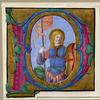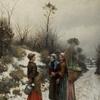Three Joseph Henry Sharp Paintings Donated to the New Mexico Museum of Art
- SANTA FE, New Mexico
- /
- October 15, 2018
Three paintings from renown Santa Fe artist Joseph Henry Sharp, a founding member of the Taos Artist Society, have been donated to the New Mexico Museum of Art. The donations were made by Lore Thorpe, the daughter-in-law of Kathryn V. Thorpe, the former owner/manager of Bishop’s Lodge.
Joseph Henry Sharp (Sept. 27, 1859 – Aug. 29, 1953) was one of the earliest European-American artists to visit Taos, New Mexico, which he saw in 1893. During his long and prolific career as a painter, Sharp was best known for his realistic portrayal of Native Americans., and a significant body of work of still life. The three donated Sharp paintings (featured above left to right) are all circa 1935: Flowers on Rio Grande Blanket, Taos Cañon and Marigold-Calendula.
“The Museum of Art currently holds 16 works by Sharp in its permanent collection, but these are the first two flower paintings and they are gorgeous,” said Museum of Art Director Mary Kershaw. “We are grateful for this significant donation to the Museum from the Thorpe family and proud to supplement our collection of works from the man considered the ‘spiritual father’ of the Taos Artists Society.”
Kathryn V. Thorpe owned and managed Santa Fe’s Bishop’s Lodge from the late 20s through the mid-50s. Bishop’s Lodge is an iconic 1920’s resort situated on 317 acres in the foothills of the Sangre de Cristo Mountains in Santa Fe. Kathyn Thorpe bought the paintings directly from Sharp. A friendship evolved, and Kathryn helped Sharp sell his artwork to some of the patrons at Bishop’s Lodge.
When Kathryn died in 1979, the paintings remained in the Thorpe family and were passed to her son James Thorpe. When James died in 1992, the Sharp paintings went to his wife, Lore Thorpe who recently contacted the Museum of Art to donate them. Lore Thorpe says, “It was always intended that they be left to the Museum of Art.”
“I’m very happy these beautiful paintings are going to be in a place where they will be honored and respected,” said Lore Thorpe. “and that the public is going to be able to see these paintings because they are truly exceptional.”







31100x100_c.jpg)







